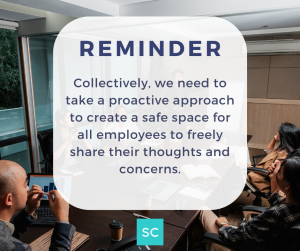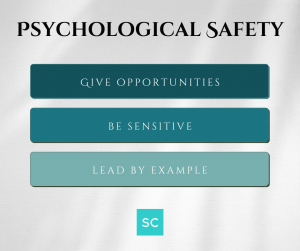Creating An Inclusive Speaking Environment
Have you ever been in a meeting where you notice a few people sitting in silence while conversation is happening all around them? For some of us, speaking up in meetings feel natural. For others, it’s a lot harder. A recent survey revealed that only a small percentage of employees consistently share their thoughts and opinions with their managers. Shockingly, just 13.6% of the employees said they consistently speak up.
While speaking up can often feel like an individual behavior, all of us can create a place that fosters an inclusive speaking environment for all. This is especially important for people in underrepresented groups who may feel additional points of friction to speaking up. Below are two strategies to consider for us to adopt a leadership communication mindset to create an inclusive space:
1. Psychological Safety
According to a study conducted by Google, teams that operate in a psychologically safe environment tend to perform better. The ROI is clear, so how can we implement this?
Consider the following:
- Give Opportunities – As leaders, it’s essential for us to be in tune with every member of our team. We have a responsibility to create an inclusive environment where everyone feels comfortable and encouraged to share their thoughts and ideas. One way we can do this is by being mindful of the dynamics within our discussions. If we find ourselves dominating the conversation and others haven’t had a chance to contribute, we can wrap up our own input and actively create space for others to take the floor. We are demonstrating everyone’s input is valued.

- Be Sensitive – Building psychological safety also involves being sensitive to social dynamics within the group. It’s crucial to be aware of how others are feeling and to respond accordingly. Sometimes, people may not explicitly express their emotions, but they might communicate through nonverbal cues. For instance, someone might appear tense or hesitant, indicating that they may not feel completely at ease speaking up. As leaders, it’s essential to create a space where individuals feel safe enough to express their thoughts and concerns, even if they may not vocalize them directly.
Creating a safe space where everyone feels comfortable speaking up is a collective effort. Each and every one of us plays a role in fostering an environment of psychological safety.
2. Leading By Example
If we truly want our teams to embody psychological safety, it’s essential for us as leaders to lead by example. We can’t just talk about it; we need to actively demonstrate it through our actions.
Consider the following:
- Showcasing Vulnerability – Instead of leading our team from a distance, it’s important for us to bridge the gap and show we truly understand the challenges our team members face. One effective way to do this is by sharing our own experiences. By showcasing vulnerability and talking about shared experiences, we humanize ourselves and foster a psychologically safe environment.

- Engaging – Engaging with our team goes beyond just fulfilling our roles as leaders. It involves taking proactive steps to foster meaningful connections with each team member. One effective way to do this is by actively getting to know others on a personal level.
- Build Trust – When it comes to creating a psychologically safe speaking environment, trust plays a crucial role. We want every member of our team to feel empowered and comfortable sharing their thoughts and ideas openly. One effective way to build trust is by being mindful of our tone of voice. Think about how we respond when someone presents an idea that may not hit the mark. Do we dismiss it with a sarcastic tone or do we approach it with the same consideration we give to any other idea? Our tone of voice can have a significant impact on how our team perceives us and whether they feel safe expressing themselves.
Creating an inclusive and safe environment where everyone feels comfortable expressing and sharing their ideas is important. It sets the stage for meaningful conversations and encourages the free flow of thoughts and perspectives.
When individuals feel psychologically safe, they are more likely to express themselves authentically and contribute their ideas without fear of judgment or negative consequences.
__
Whenever you’re ready, there are 3 ways we can help you:
- Discover your communications style so you know where to start. Over 4,000 people have found theirs here.
- Attend our monthly communication workshop to build communications confidence (new topics: public speaking, advocating for yourself, building credibility, etc) here.
- Get your brand in front of 43k+ people by sponsoring our newsletter or Soulcast Media | LIVE LinkedIn events [contact: hello@soulcastmedia.com]











